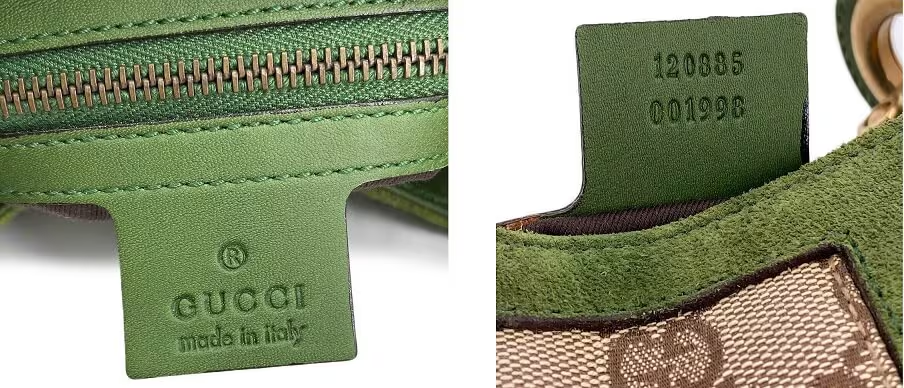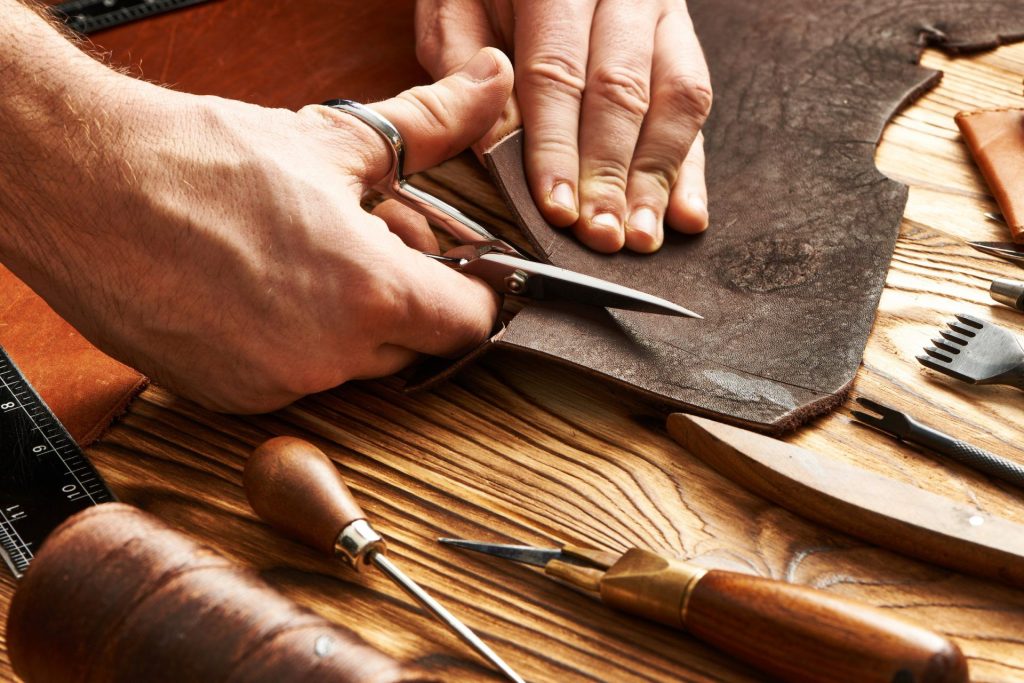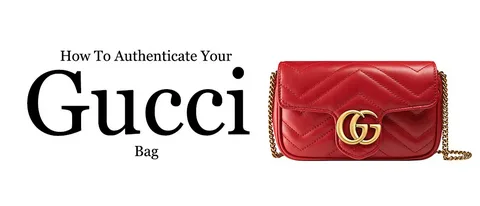Gucci is one of the most heavily counterfeited luxury designer brands in the world due to its myriad of iconic styles and design cues in its handbags. Ranged among Chanel, Hermès, and Louis Vuitton, Gucci has always been at the peak in matters related to luxury fashion.
Top-notch materials, premium workmanship, heirloom styles as well as characteristic Gucci pizzazz namely bamboo handles, horse-bit closures, and GG monogram canvas have helped Gucci bags to become so different from others.
However, it is important to know your way around the real deal and be able to identify counterfeits when shopping for pre-owned Gucci handbags, as there are tons of fakes out there. The following guide contains tips and red flags that will help you conduct a DIY 5-step authenticity check on a pre-owned Gucci bag.
Step 1: Check the Serial Number Tag:

● Examine the handbag’s interior, close to the zipped pocket, for a rectangular leather tag that is perpendicular to the front closure of the bag and has sharp angles on it.
● This rectangular tag has two sides that need to be examined closely: the back will carry the serial number, and the front should have three lines of heat-stamped text.
● On the front of this tag, ensure that the top line is the trademark ® in a circle.
● Right beneath should have “GUCCI” written in the all-capitalized signature Gucci font looking carefully at the font the letter ‘G’ and the two ‘C’s look round like incomplete circles.
● The words “made in Italy” should appear immediately below in all lowercase letters.
● Ensure that the entire heat stamp is justified in the center and the font is authentic.
● Compare the font on the tag of the bag in question to the image below to see if the fonts match.
All three lines should justify to the center of the tag. The heat stamp must be clear and crisp. An authentic serial number tag has Gucci’s number font with serifs—feet—at the end of the number, much like a typewriter font—on the back side.
The back of a modern rectangular serial number tag will always have 10-13 digits in two rows. The first row will give the handbag style, and the second represents the supplier or batch code. This code contains only numbers; it also has serifs on the font—that is, feet.
However, be sure to note that this code is not unique to your specific bag – other bags identical to yours that came from the same series and supplier will have the same code, therefore two authentic Gucci handbags can share the same serial number sequence.
Also note that vintage Gucci handbags often have one row of less than 10-13 digits, located on more rounded leather tags.
What if my bag doesn’t have a rectangular tag?
● Vintage Gucci bags predating the 1960s have a model number on the tags.
● In the 1960s, some of them do, and some don’t have model numbers.
● By the 1970s, there were no serial numbers or model numbers, just the cursive hailing in a Gucci script on a Gucci bag.
● Late 1970s to early 1980s saw the introduction of the Gucci Accessories Collection, which one can identify clearly by its gold-printed serial number, practically partially peeled and faded off now on almost all.
● Since the late 1990s, Gucci Crossbody bag often include a rectangular leather serial number tag.
The shape and style of vintage Gucci tags differ greatly. If the bag is instead claimed to be of a newer model and such a tag is absent, then there is an immediate red flag of counterfeiting. From 2016/2017 onwards to 2021, Gucci has incorporated a QR code on the serial number tags as a counter-authentication measure—usually found on a black fabric tag inside the handbag that is readable with smartphones.
Step 2: Check the Materials and Craftsmanship:

While being the epitome of luxury, Gucci, of course, would use only the best raw material quality and superior craftsmanship for creating their handbags. That is why you can find even very vintage Gucci handbags from the 80s and 90s in such amazing, like-new condition.
One look at a used Gucci will immediately tell you the quality of the bag. If you can see the bag face to face, feel the material of the bag.
Whether it’s Gucci’s signature GG monogram canvas, Guccissima the most Gucci leather; calf or suede leather; or the smaller number of rare, exotic crocodile skins, Gucci’s materials feel luxurious to the touch. Counterfeits will often use cheap leather that will look, feel, and even smell unnatural due to being machine-made and finished in poor-quality chemicals.
Step 3: Examine the Stitching.
Genuine Gucci handbags are expertly crafted, with threads that occasionally match the color of the bag but do not usually do. The bag is most certainly fake if you see any uneven stitching, fractures, or gaps in the threading or fraying.
Step 4: Feel the Hardware.
What sets the hardware of the handbag apart is that it uses a large difference in style for the brand, marking its varying styles of handbags and evolving design ethos. Most importantly, the Gucci logo used to be the interlocking G’s, and now it is the Marmont GG for that overlapping style.
Some of the most iconic hardware features of Gucci bags include the horse bit closure, the piston lock on Jackie O Hobo bags, and the bamboo closure and handles. While each type of hardware from Gucci will have the characteristics that make it unique, there is only one common denominator among them: quality. All real Gucci handbags will have quality,
hefty hardware—not light and cheap, not prone to scratches, and certainly not covered in plastic.
Gucci’s bamboo hardware was the result of leathers and metals in World War Two undergoing a transformation of how to be supplanted, molded with painstaking precision over an open flame before being varnished to develop a patina in a one-of-a-kind bronze hue. It comes with a density and opulent feel in the hand, which sets.
Step 5: Look for an Authenticity Card.
You may encounter something like a “controllato” card when purchasing a pre-loved Gucci bag. It’s gray, written in the same font, ‘GUCCI’, with 10 numbers, and the word “controllato” in lowercase. This card comes with any new, authentic Gucci bag; however, do not fall for the fact that the presence of this tag confirms the authenticity of the bag. Actually, it is very easy for a counterfeiter to produce this card along with the purse. Never buy on the basis of the card alone.
On the contrary, if you don’t find this “controllato” card with the pre-owned Gucci bag, there is not a single thing that you need to worry about. Quite a lot of these cards are lost, in the sense that they are not peculiar with each bag but generic with all new bags from Gucci—meaning the bag can still be authentic without one. In fact, many reputable luxury resale companies will provide their own type of authenticity card certifying that the bag is authentic. These same resellers will typically provide a money-back authenticity guarantee, and the best resellers will provide a lifetime authenticity guarantee – not just one that expires after the typical 30-day return period.
With Gucci producing several landmark changes and classic designs throughout the years, differentiating between authentic Gucci purses at first may seem difficult. On the flip side,
spotting fake ones would be effortless provided that you know what are the basic traits found in every genuine Gucci handbag
